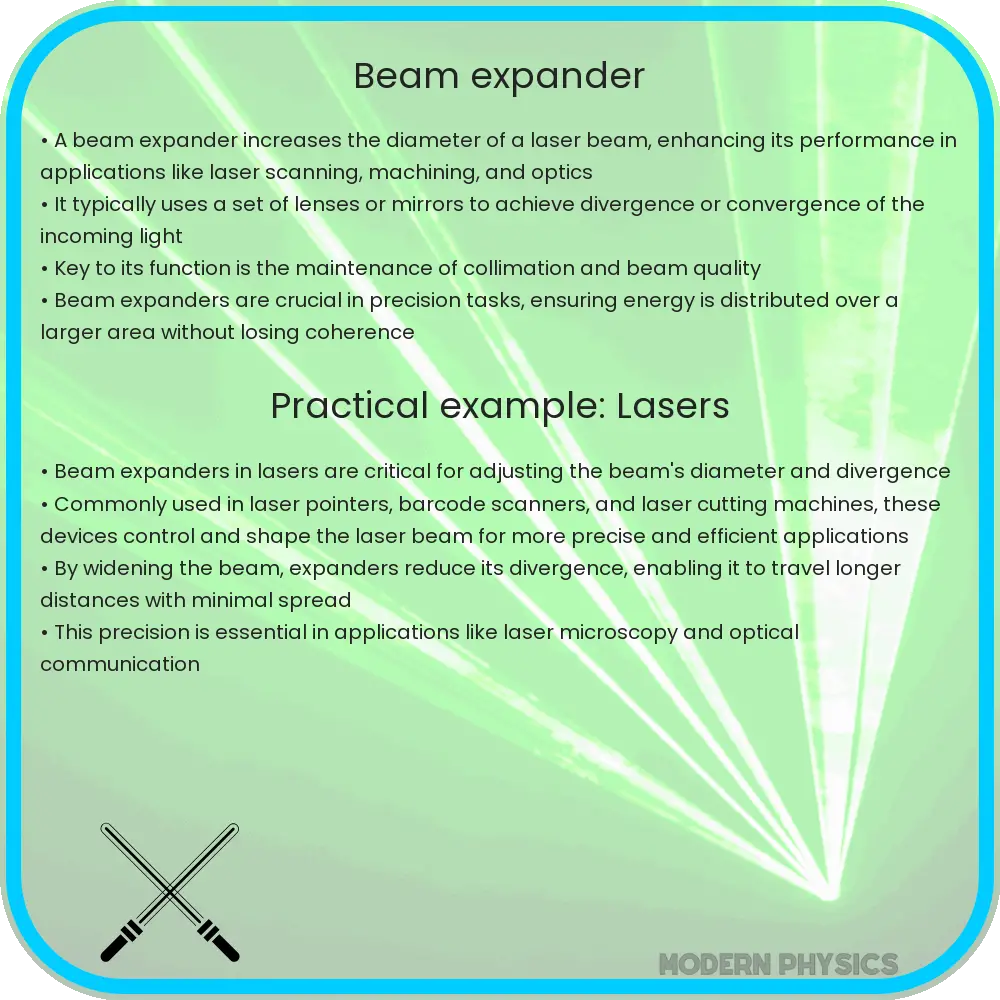Beam expanders enlarge laser beam diameters while maintaining properties, crucial for applications like laser ranging, interferometry, and communications.

Beam Expander: Precision, Versatility & Design in Optics
A beam expander is an essential optical device used to increase the diameter of a laser beam while preserving its other properties. These devices play a crucial role in various applications such as laser ranging, interferometry, and communications. Understanding the basic principles, design, and functionality of beam expanders is key for anyone interested in optics and laser technology.
Basic Principles of Beam Expanders
Beam expanders consist of a combination of lenses or mirrors arranged to enlarge an input beam to a larger output beam. Typically, they employ a Keplerian or Galilean configuration:
- Keplerian Beam Expanders: These use two convex lenses. The first lens collates the incoming light to a focal point, and the second lens re-expands the collimated light. This setup can provide higher magnification and is capable of producing a projected beam with excellent collimation.
- Galilean Beam Expanders: These consist of a negative (concave) and a positive (convex) lens. The concave lens diverges the beam before it hits the convex lens, which then collimates the light. Galilean beam expanders tend to be more compact and lighter than Keplerian designs.
The magnification factor \( M \) of a beam expander is given by the ratio of the focal lengths of the lenses used: \( M = \frac{f_2}{f_1} \), where \( f_1 \) and \( f_2 \) are the focal lengths of the first and second lenses, respectively.
Precision and Versatility
Beam expanders are known for their precision and versatility. Precision comes from the capacity to create an output beam with an expanded diameter but a well-maintained collimation, which is essential for applications that require high accuracy.
Versatility is achieved through adjustable beam expanders, which allow for a range of magnifications. This adaptability makes them suitable for various tasks, from laboratory research to industrial applications. Some beam expanders also include features like variable divergence, providing even more control over the beam properties.
Design Considerations
Several factors must be considered when designing a beam expander:
- Wavelength Compatibility: The lenses or mirrors used in the expander should ideally be optimized for the specific wavelength of the laser to minimize absorption and maximize transmission.
- Beam Quality: The quality of the expanded beam should be high, with minimal distortion and divergence, to ensure the effectiveness of the subsequent optics or application.
- Size and Weight: Depending on the application, the size and weight of the beam expander can be critical. Devices used in portable systems should be as compact and lightweight as possible.
- Material and Coatings: The choice of materials and coatings for the lenses or mirrors can significantly impact the performance, especially in high-power laser applications.
Applications of Beam Expanders
Beam expanders have a wide range of applications across various fields:
- Laser Ranging and LIDAR: By expanding the laser beam, the precision and range of laser distance measurements can be significantly improved. This application is crucial in fields such as geodesy, atmospheric studies, and autonomous vehicle navigation.
- Interferometry: In scientific research, expanded laser beams are necessary for interferometric measurements, where the interference patterns of light are used to measure extremely small displacements, refractive index changes, and surface irregularities.
- Optical Communications: Beam expanders are used to shape and direct laser beams in free-space optical communication systems. The expanded beam can travel longer distances with reduced divergence, ensuring efficient data transmission.
- Laser Cutting and Engraving: In industrial applications, an expanded beam can be focused to a very fine point, enabling precise cutting and engraving on various materials.
- Medical Devices: Beam expanders are integral to various medical instruments, including certain types of microscopes and laser-based diagnostic tools, where a well-collimated expanded beam is necessary for accurate imaging and treatment.
Maintenance and Safety
Proper maintenance and safety precautions are essential when using beam expanders:
- Regular Cleaning: Lenses and mirrors should be kept clean to avoid any obstruction or distortion of the laser beam. Dust and debris can affect the performance and even cause damage to the optics.
- Alignment Checks: Regularly check the alignment of the optical components to ensure that the beam path is collinear with the optical axis of the expander. Misalignment can result in beam distortion and reduced efficiency.
- Safety Precautions: Lasers can be hazardous. Always follow appropriate safety guidelines, such as wearing protective eyewear and ensuring that the laser beam path is enclosed or clearly marked to prevent accidental exposure.
Conclusion
Beam expanders are indispensable tools in optics and laser technology, offering precision, versatility, and control over laser beams. By understanding their principles, design considerations, and wide range of applications, users can effectively harness the power of lasers for various scientific, industrial, and medical purposes. Proper maintenance and adherence to safety protocols ensure the longevity and safe operation of these sophisticated devices. As technology continues to advance, beam expanders will undoubtedly play a crucial role in the development and enhancement of optical systems and applications.
